What Are Clarity Enhanced Diamonds? Are They Any Good?
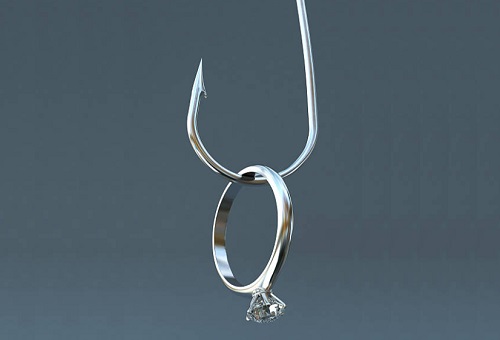
Clarity enhanced diamonds are often touted as a cost-effective way to buy a larger carat diamond without breaking the bank. But what does clarity enhanced mean and what are the things that you need to be aware of?
In this write up, you will find everything you need to know about clarity enhanced diamonds and why they are absolutely terrible purchases. By the end of this article, you’ll be thanking me for saving you money and not getting ripped off by unethical jewelers.
Let’s get started…
What Are Clarity Enhanced Diamonds?
Clarity enhancement is a form of treatment performed on natural diamonds to remove unsightly flaws, blemishes and inclusions. You can also think of the process as performing “plastic surgery” on very low clarity diamonds (e.g. I2/I3) in order to hide or make the offending inclusions less visible.
In the industry, there are two main types of clarity treatments that are used on a commercial scale; laser drilling and fracture filling.
External Laser Drilling Treatment to Improve Clarity
Laser drilling is a method used in removing inclusions inside the body of a gemstone. This treatment is usually applied on large carbon inclusions or dark colored crystals embedded within the diamond’s crystalline structure
First of all, a tiny tunnel is drilled into the surface using a laser beam to create a pathway to the inclusion. Through that tunnel, strong acidic chemicals are forced into the opening to dissolve and bleach out the inclusions. Typically, a mixture of concentrated hydrofluoric acid (HF) and sulphuric acid (H2So4) is used.
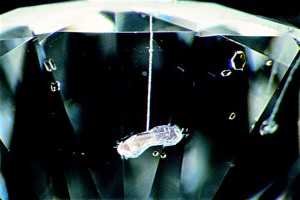
Profile view of laser drilled diamond showing a tunnel reaching the inclusion – GIA
Generally speaking, laser drilling will not weaken the structural integrity of the diamond to a serious extent. It doesn’t leave any foreign material inside the diamond after the process is performed. When proper drilling techniques are applied, the only observable sign of laser drilling is a microscopical tunnel that extends to the inclusion from the surface.
Now, if you are wondering whether laser drilled diamonds (or any form of enhanced stones) are good buys, let me tell you straight up that you will be sorely disappointed. You need to understand that clarity enhanced diamonds usually originate from garbage tier quality diamonds that are unwanted and unsaleable.
When these stones are polished, little attention is paid to achieving better cut quality because it doesn’t make economic sense to do so. The truth of the matter is that 99.99% of clarity enhanced diamonds are absolutely terrible in terms of cut standards.
I can tell you that the general consumer is far better off by lowering expectations of the 4Cs and sticking with an untreated diamond.
Internal Laser Drilling (Made to Resemble Natural Flaws)
Besides using lasers to create surface reaching tunnels, newer methods of internal drilling had also been researched and applied in recent years. You are probably wondering; why would people want to use internal laser drilling instead of the traditional laser tunneling?
Well, the reason behind using internal drilling involves a malicious intent to deceive consumers as this treatment is often undisclosed.
You see, internal laser drilling creates many small cleavages with seemingly non-discernible patterns. These “tunnels” serve the purpose of bridging the inclusion to the surface without the use of a direct laser tunnel.
The problem with these irregular and worm-like looking channels is that they are purposely made to resemble feathers and passed off as being “natural” flaws.
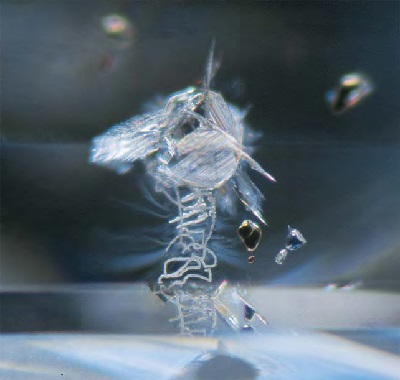
Artificial treatment that resembles natural feather inclusions.
For this type of treatment, diamonds with dark inclusions near their surfaces are usually selected for enhancement. After the worm-like channels are drilled, the diamond is subjected to a series of bleaching solutions to dissolve the unsightly inclusions.
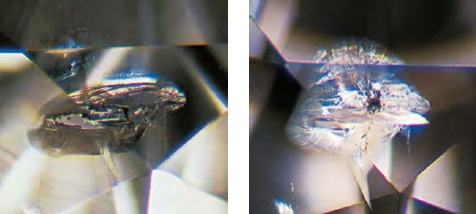
Black coloration is significantly reduced after treatment
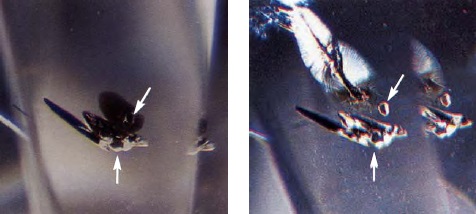
Both dark crystal and feather are no longer that obvious after laser drilling
Source: A New Lasering Technique For Diamond (GIA)
Important note: always ask for a GIA or AGS certificate when buying a diamond. If the jeweler refuses to show you one or tries to promote other reports of dubious origins, it immediately subjects the diamond to suspicion.
Besides grade bumping or clarity enhancements issues, I can tell you from experience that the jeweler is not only trying to rip you off but also likely be hiding other major issues from you.
Besides grade bumping or clarity enhancements issues,
Fracture Filled Diamonds – “Repairing” the Cracks
Although cavities and surface reaching feathers can be removed through polishing, there is a method which does not lead to significant carat weight loss. Fracture filling is the process of inserting glass or liquid glass-like filler material into surface scratches and cracks.
Since the filler possesses similar optical properties (refraction) as that of a diamond, the flaws become less visible after the liquid filler is solidified. The Yehuda Diamond Company pioneered fracture filling and is also the industry leader for fracture filled diamonds.
Their business model and goal of enabling consumers to purchase larger diamonds at less expensive prices have seen some success. Since then, many other companies had tried to emulate their success and started developing their own proprietary method for fracture filling.
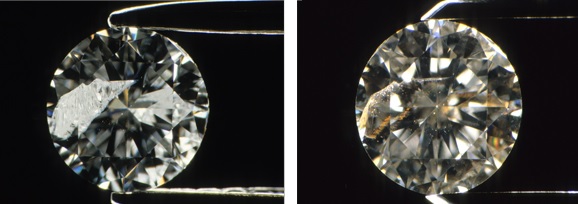
Fracture filling can enhance the appearances of feathers and open cleavages – GIA
Now, the problem with fracture filling is that it results in a stone which is no longer made of a uniform material. Despite advances in material science, the filling substance still has vastly different material properties compared to the host diamond.
You see, diamonds are chemically inert and exceptionally stable due to their crystalline structure. What looks almost perfect after the treatment process might fade with the passing of time. Or worse still, the filling might even fall out in extreme cases.
Typically, when the fillings are exposed to harsh temperatures or strong chemicals like concentrated acids or alkali, the filling would start to degrade or fail. Because of its non-permanent nature, most companies offer lifetime “repairs” for fracture filled diamonds in an attempt to market their products.
But here’s the thing, the problem with reworks and a second filling is that it isn’t going to be as good as the first. Also, another limitation of this technique is that once a diamond is filled with a resin, it is impossible to reverse the process completely.
Note that GIA (Gemological Institute of America) does not grade fracture-filled diamonds because these treatments aren’t permanent. C.E. diamonds are usually separately appraised or graded by other labs with dubious standards.
Should You Buy a Clarity Enhanced Diamond? What Are the Pros And Cons?
Clarity enhanced diamonds are often marketed for their lower price points and “better” looking appearances. For unsuspecting consumers who don’t know better, let me spell it out for you.
The diamonds are cheap for a reason.
That’s because these clarity enhanced diamonds usually start out as junk tier diamonds in the low I2-I3 clarity ranges. The problem I have with scumbag jewelers is that they misrepresent these low quality diamonds and make incorrect comparisons to properly graded diamonds.
Jewelers who sell these clarity enhanced diamonds often use prices for GIA graded VS or VVS diamonds as a benchmark. Obviously, these GIA diamonds are going to cost more! In truth, the far more accurate price comparisons would be to use GIA I2-I3 diamonds instead.
Why? That’s because unethical jewelers like these want to provide you with the false impression that the clarity enhanced diamonds are worth more than they are. And in many cases, these clarity enhanced diamonds are priced at a BIG premium to GIA I2-I3 diamonds!
You aren’t getting a better deal and you are actually overpaying for inferior quality!
Why You Should Avoid Clarity Enhanced Diamonds Like the Plague

As a consumer, clarity enhanced diamonds are a can of worms and I strongly recommend that you stay away from them. Let me explain why they are bad purchases and the issues with treated diamonds.
If a diamond has a lot of inclusions that is treated via laser drilling, the diamond can end up with a lot of tunnels which can weaken its structural integrity and cause durability issues.
Also, fracture filling is not a permanent process and the diamond’s appearance can quickly deteriorate if the filling substance degrades. The most common problem with these fillings is that they turn cloudy or hazy. Extra care is also required as the glass-like filling substance cannot be exposed to chemicals or even simple ultrasonic cleaning routines.
Now, if you are kept up to date with the latest industry news, you will realize that clarity enhanced diamonds have always received a lot of negative attention. The main reason behind the negative press largely stems from people who found out they had been duped into buying an enhanced diamond at the point of sale.
Even though jewelers are required by law to fully disclose any clarity enhancements to the consumer, there are many rogue jewelers who intentionally hide these details in order to make a sale. That’s why you have to be extremely careful and knowledgeable when buying such diamonds.
Summary: Clarity Enhanced Diamonds – Good or Bad?
I personally think that clarity enhanced diamonds are not worth the money and trouble to buy. But ultimately, you have to make the decision for yourself.
If you have an unrealistic expectation of buying a super large size diamond on a small budget, buying a clarity enhanced diamond would be one way to achieve that. You just need to understand that you are likely going to overpay for an inferior quality diamond.
If you still decide to go ahead with an enhanced diamond after reading this article, you probably deserve to get ripped off. In my opinion, untouched natural stones are still the best choice when it comes to buying diamond jewelry.
Related Articles
Leave A Comment

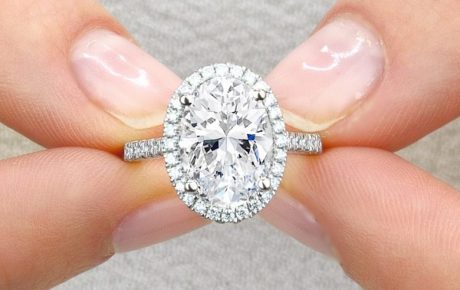
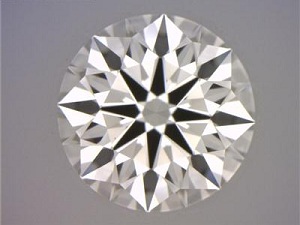
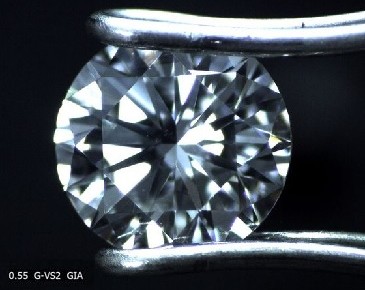










18 Comments
I’m considering a clarity enhanced diamonds for sale on eBay. The reviews of the seller seem reasonable and legit. It is a .5 carat VS2 F very good cut (round) under 900. Strict budget…should I?
Also, do clarity enhanced diamonds last and keep their value overtime?
Let me say from experience that eBay listings are full of scams and misrepresentation. You have to be extra careful.
First of all, you need to understand that quality diamonds never go on sale regardless of it being enhanced or treated in any manner. You should be asking yourself: who graded the diamond?
A Very Good cut is equivalent of terrible cut quality and that’s just a nice way of putting it. So far, my reviews of clarity enhanced diamonds have left nothing but a bad taste in my mouth because of the terrible cut quality and misleading manner in which they are sold.
Lastly, to address your question about how long enhanced diamonds last really depends on the kind of care and treatment that the stone has undergone. Temporary treatments like Yehuda will require special upkeep and care.
Unlike untreated diamonds, clarity-enhanced diamonds have little trade in or resale value. If you ever wondered why jewelers don’t offer buybacks or trade ups for these diamonds, that’s because they know they have no value and its hard to find a secondary buyer. Once they sell it to you and the money is in the bank, there’s no need to stand behind the product.
I’ve recently inherited a diamond engagement ring which has a document stating that it is clarity enhanced. To my untrained eye, the diamond looks a little hazy and I’m wondering whether people would be able to tell my diamond has been enhanced.
I’m sorry if the next question sounds stupid. Are they real or fake diamonds?
Clarity enhanced diamonds are created from REAL diamonds. What happens is that they undergo certain treatment processes to fix undesirable elements in their clarity.
The hazy appearance could be due to many reasons. One, the inherent nature of the inclusions in that diamond. Two, the degradation of the filler/enhancement material. Three, a dirty diamond. Four, you may not know what you are seeing.
To the layperson, I doubt they can identify the technical differences between a natural and a clarity enhanced diamond. But here’s the thing, the diamonds that are used for clarity enhancement are garbage tier stones in terms of cut quality and performance. They aren’t cut well and just because its clarity is improved doesn’t make them look a whole lot better.
Sounds like you are salty because treated diamonds look better and are cheaper than the huge markup “better” diamonds.
You are definitely right that clarity enhanced diamonds are cheaper and you are somewhat right about the markup. What you’ve gotten wrong is how they look better. They aren’t. Cut quality dictates that. Also, the mark up is for the jeweler to make more money off these low quality diamonds and not so much about saving money as a consumer. If you are oblivious to good advice and think I’m salty, by all means go out and buy a clarity enhanced diamond to prove me wrong. And when you do get ripped off and overpay for inferior quality, then you will know who’s right.
Hello,
I purchased a diamond ring for £1000. It’s 1 carat D VS1. The diamond itself is lovely and sparkles a lot nicer than diamonds from other colleagues at work but now I am afraid I’ve made a mistake. I did not want to spend > £2000 on 0.5 carat and my only other alternative was a lab grown – was waiting on larger size or moissanite.
I agree with the ratings for these diamonds, I won an auction from the same company for H colour VS2 and it looked more yellow than my I colour DBTY!
I think these diamonds are good for those who are aware that they aren’t an investment and very much like a car – mine probably a right off car that was repaired.
As a south Asian, we invest more in pure gold and silver items rather than gemstones as these hold more value and that’s the case with myself.
Sorry, but I’m going to pop your bubble about a CE diamond looking better than a non-treated stone. Unless your colleagues are all buying ultra low quality garbage, I highly doubt what you are saying is true. You are probably delusional to think that you can get a high quality diamond that is correctly represented. Seriously? £1000 for a 1 carat D VS1? Who graded the diamond? You don’t have to tell me and I would already know the answer. It’s definitely not GIA or AGS or even a 3rd tier lab like IGI. It’s some unknown in-house “certification” or appraisal and its a big rip off. You can be sure that it isn’t a D color and definitely NOT a VS1 clarity diamond. If you are on a budget, get a CZ ring instead. Getting a diamond at this kind of prices and still getting ripped off doesn’t sound like a deal at all to me.
Hi!
Thank you very much for such a useful information! I have a little question concerning clarity enhanced diamonds. Is it true that it’s not possible to “improve” clarity more than two grades, i.e. if a diamond had I3 before the treatment, after enhancing it will be I1? Non?
Kind regards,
Kris
It is possible to improve the clarity grade by more than 2 grades. For example, if a diamond is reliably graded as SI2 with a BIG, semi transparent feather inclusion only, injecting the feather with a filler material to make the inclusion “invisible” can improve its grade to a VS2 or a VS1.
The thing is, who graded the I3 diamond? I3 diamonds are trash and they are so chock full of inclusions when GIA grades it. If an unreliable source like your jeweler or your jeweler’s appraiser says its an I3, you can be sure that it’s far worse than an I3 grade. These diamonds are gone beyond the point of rescue. And if you think you can magically get a good looking diamond after enchancement, you are being delusional.
Great page and info Thank You.
Though not an expert by any definition. I have been buying diamonds for my wife for thirty years, and glad I did research on the way. We have bought from two Jewellers in Hockley Birmingham. The first major purchase was a 0.89 ct solitaire. The jeweller was interesting and showed a range of stones either side of our budget so we could see the differences. And thats when we saw his tattoo number on his arm..We bought,exchanged and upgraded many times before he properly retired and he passed us on to another jeweller in the quarter.
We do not pay excessivley (except for the 1.5ct princess cut fully certified solitaire :-) ) we want them to be around and give us great service and we know we never pay ticket price.
I hate the number of ads on facebook with large very poor CE stones. And on shopping channels where they state certified stiones and they are I3 on a little card sized report. You can have certified rubbish
To your readers, go out find a jeweller that you like, stick with them and enjoy those moments of looking and buying.
I must say, I find the delusional commentary and tone here to be excessive. I adore my diamonds and am fortunate to have an extensive collection – from a GIA round triple X O VVS2 4.09ct to an EGL cushion L VS1 4.03ct (this one is my wedding ring) to a non-certified 3.37ct old mine F I1 that is laser drilled and still has one faint carbon spot dead center over the large, open cutlet, making it shockingly difficult to spot. There are many other diamonds in the collection, ranging from 1.5ct European cuts to a lovely 4ct Georgian rose cut. And even more non-solitaires!
I knew what I was buying when I bought my CE diamond – and I paid fairly for it (read: stupid cheap). The seller was open, honest, and described it for exactly what it was. I normally wouldn’t consider a CE stone, but this one spoke to me and I am so glad I bought it despite my reservations about an “inferior” CE diamond. It is certainly the nicest I1 I’ve ever laid eyes on and its chunky facets face up beautifully. This lovely mine cut has a different sort of sparkle than a diamond like the round brilliant triple excellent GIA.
I prefer excellent clarity and warm color, and I especially adore antique cuts… Are my preferences the ideal on the market? No. Do I care? Big fat NO. I buy what I love… you should too. I have larger and “nicer” diamonds that I love less than this “low quality” diamond. I wear it as a right hand ring near daily.
To me, it was not a “bad purchase” and I certainly don’t “deserve to get ripped off” as your article says. Is it as objectively nice as some of my other diamonds? Nope. Is it perfect for me nonetheless? Yep.
With reasonable expectations, a buyer can get the right diamond FOR THEM at the right price – clarity enhanced, diamond alternative, small, large, white, warm, or anything in between. The key is an informed buyer. Be smart, know what you are buying and what to expect in the future, understand that many grading labs adhere to standards well below GIA and certifications from many of these labs aren’t worth the paper they are printed on – and always VERIFY EVERYTHING with a reputable, experienced jeweler… twice if you are buying online.
The only wrong decision you can make is an uninformed decision. Buy what you love and don’t get ripped off.
Thanks for the comment. I fully agree that you should buy what you love. Clearly, you did your research well and know what you are buying. That’s really the key to buying any diamond jewelry and to enjoy the purchase. However, stories like yours are rare and more of an exception than a norm because of the way the market is structured and how sellers work with CE diamonds.
If on a budget I would definitely go with a lab grown diamond over clarity enhanced, at least you know what you see now is what you will have long term. Except in rare circumstances a diamond is not a good investment anyway. I feel like a young couple should go with a lab diamond or moissanite and bank the money saved and use it towards a down payment on a house.
Think twice why You need a diamond.
Do You really like it or You are buying because the rest is buying?
I personally think it’s totally overprized asset wit limited appearance.
Only by evening You see the sparkling, during the day it is useless.
I moved to more attractive alternatives like aquamarines or tourmalines You can enjoy the whole day.
I generally agree with what you say. Diamonds are a result of clever marketing by De Beers. I think you are wrong about them being an asset. Diamonds are actually bad store holders of value especially if they are bought at retail prices. But they do have their place in our society. If women want it and if your fiancee wants one, then the best thing to do is to fulfill the need.
They have some enhanced colored diamonds on ebay. I have always dreamed of a pink diamond ring, but the cost has always been way too high. Are your thoughts the same on the clarity enhanced colored stones? Are there better alternatives?
Clarity enhanced and color treated diamonds are a can of worms because of the lousy quality of the base stone that it began life with. If you cannot afford a natural pink diamond ring, conisder taking the route of the lab grown option